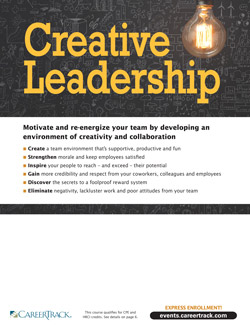Leading Yourself and Respecting Others Into the New Year
Good leaders and managers know you can’t lead others until you know and can effectively lead yourself. Understanding your own strengths and development needs helps you both respect yourself, and lead others. This article focuses both on leadership and developing a culture of respect as we close out the year and look towards new beginnings.
Leadership Fundamentals: Developing Yourself
Many leaders have had a lot of success in leading others and helping them develop. This may include helping professional staff develop the core skills needed to do their job, or helping new supervisors and managers hone their own leadership skills. It is also critical, however, that leaders self-reflect on their own skills, assessing their own strengths and development needs in leading themselves and others.
When was the last time you thought critically about developing YOURSELF as a leader? Do you know what questions to ask yourself? Can you name the ways you can learn new leadership skills? Do you know how to assess and improve your own ability to support the growth of others?
Pryor’s Leadership Fundamentals: Developing Yourself (registration required) is a great example of a quick on-demand video course that provides valuable and broad insights – and a helpful roadmap – in a short amount of time. The course reviews questions you should ask yourself and discusses ways to make improvements. The course also covers important things to avoid.
Here are some key topics in the training:
- Questions to ask yourself about your own leadership to assess your strengths and weaknesses
- Options for designing a personal leadership development action plan that engages both you and your team
- Reviewing different ways to learn – including trial-and-error, educational and observational – along with their benefits and downsides
- Things to avoid in developing yourself and others
The course comes with a useful downloadable reference to help you track the content and create your plan.
SAVE $10 AND TRAIN ON THIS TOPIC TODAY
Balancing Authentic and Situational Leadership
Pryor’s video reminds us that when we reflect on our own leadership skills, it is important to balance the need to be ourselves, with the need to adjust our own style to meet others’ needs. This requires a balance between authentic leadership – being our own true selves in a consistent and predictable way – and situational leadership – flexing our leadership style to meet the needs of a situation and other people.
Doing this requires an ongoing balance between self and other. For self, I am aware of myself and my feelings; my strengths and weaknesses; and how I most often show up in the world, both when things are going well and when I am experiencing stress. For others, I am aware of your style, strengths and weaknesses; what the situation calls for; and our shared mission and goals. Taking care of both requires tremendous and sustained self-awareness and discipline.
Reflecting on your leadership style today may also highlight the need for a “reboot” given the significant changes many have experienced in the workplace over the past few years. Many leaders are leading more remote and telework-oriented teams. People continue to face work-life challenges with respect to childcare and health. There are significant personal and business pressures from inflation. Sectors that have personnel shortages one day may find themselves laying off people the next.
How you approach all this depends on your personality, relationships, organizational culture, your role, your team, and your projects. In the face of societal change, the way you led before may not be the way you lead today.
Four Tools for Leadership Development
Another highlight of Leadership Fundamentals: Developing Yourself is reviewing the different tools and approaches you can use to develop your leadership skills. Here is an overview of some tools to consider as you reflect and build on your own leadership:
- Leadership Assessments – Assessments can be great tools for teaching and learning different leadership styles, and for developing specific leadership strengths. Cognitive Indicators help evaluate your data gathering, analysis, and decision-making preferences. Emotional Intelligence Assessments assess a range of soft skills, from resilience to self-awareness. Conflict Style Indicators help you learn about how you respond to conflict, including your ability to alter your approach based on needs. Strengths and Competency Indicators help you concretely identify your strengths in specific categories.
- Structured Feedback Requests – Asking for feedback, both formally and informally, provides great insights for managers. This can be as informal as a structured conversation with space to listen openly; or as formal as 360-Degree Feedback Assessment, which provides a full feedback profile, based on the leader’s own personal assessment and feedback from his or her direct reports, peers and supervisors.
- Specialized Training – Pryor’s Leadership Fundamentals course reminds us of the importance of education in leadership development. Ongoing deepening of workplace skills keeps us at the topic of our game in our workplaces. As you plan your leadership development journey, consider Pryor’s on-demand training across an array of leadership and management topics, including communications, time management and prioritization, emotional intelligence and project management.
- Action Planning – Assessments, feedback, and training provide useful data, but without action planning and follow-up, the insights may rapidly disappear. Any leadership assessment exercise should include a concrete plan to help keep you accountable to yourself and others.
Today’s world can feel both uncertain and too fast to keep up. The leadership skills needed in the past may not be the ones that will get you to the future. Let Pryor help you self-assess and develop a development plan for both you and your team!
Building a Respectful Workplace for Employees
Leaders are responsible for mission and business success, and for developing the critical human resources needed across a team or organization. Part of effective human resource development is knowing how to build and deepen a workplace that is respectful.
While no one likes to think that harassment and discrimination are problems in their workplace, effective leadership means building a respectful workplace that is free of such behaviors. Respectful workplaces are those that recognize harassing behavior; act on both illegal discrimination and harassing conduct; and have a reporting mechanism that allows for action where needed.
Pryor’s on-demand course Respectful Workplace for Employees (registration required) provides a framework and tools for addressing this sensitive topic. Using videos, scenarios and concrete tips, the course takes a practical and supportive approach to manage these dynamics in your workplace. Key content points include:
- Recognizing and addressing sexual harassment
- Defining protected classes and describing discriminatory practices
- Observing problem behavior and knowing how to respond
- Recognizing and confronting retaliatory behavior
- Offering suggested interventions when you witness inappropriate behavior
- Effectively describing harassment or discrimination if you ever need to report it
In addition to highlighting risk areas, this interactive course illustrates positive workplace behavior and gives practical tips for addressing unwelcome harassing or discriminatory conduct. This helps managers create a respectful workplace culture based on kindness, respect and positive behavior.
Linking Respect and Effective Communication
A key insight from the Respectful Workplace for Employees course is the importance of communication and emotional intelligence. The ability to read other people, share how you are feeling and provide and receive feedback can make a key difference in how actions are perceived.
Here are key leadership tips to keep in mind:
- Understand and respond to others’ emotions. Effective leaders move between the personal, the social and the organizational. They read the needs of each single person, and shape both motivation and the organization through the words they use.
- Notice your impact and calibrate. Different people have different comfort levels at work – personal compliments and teasing can be viewed very differently. To maximize effectiveness, you may need to adapt your style to be less or more formal.
- Ask for input. Listen, listen, listen – and – never let an awkward moment go to waste. Ask for feedback if you think you may have pushed someone else’s button – your uncertainty can create new space for relationship building.
- Know and take care of yourself. Every leader needs to recognize personal boundaries and see them in others. If someone else’s behavior is leaving you stressed and on guard, consider ways to talk about it and give clear feedback.
Some of these tips may be easier than others, depending on your background and personality. Here are some on-demand Pryor courses to consider when doing this work:
- Brain Bites: Empathy: The Key to Active Listening
- Mastering Communication Skills with Tact and Confidence
- Barriers to Effective Communication
- Interpersonal Communication Skills
- Social Cues and Stopping the Drama
- Emotional Intelligence: Developing Effective Relationships
As you reflect on all that has passed this year and look ahead to taking care of yourself and maximizing your effectiveness in the months to come, we hope you keep Pryor in mind. Through our blogs, on-demand training, and live workshops, we stand ready to keep you at your best today and to help you develop and deepen your skills long into the future.





